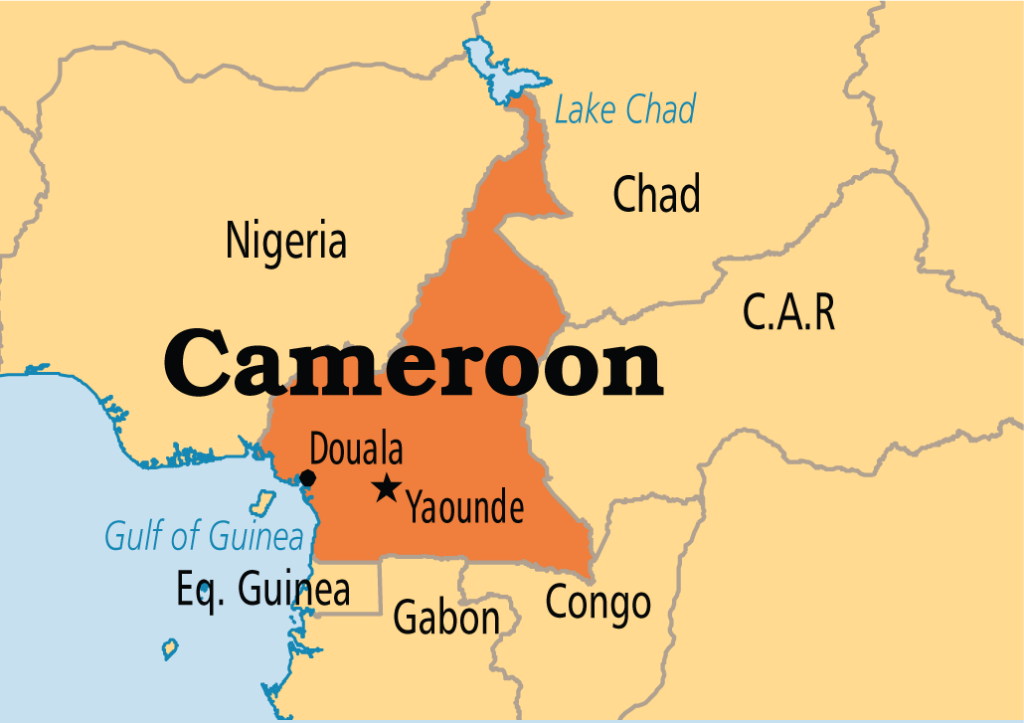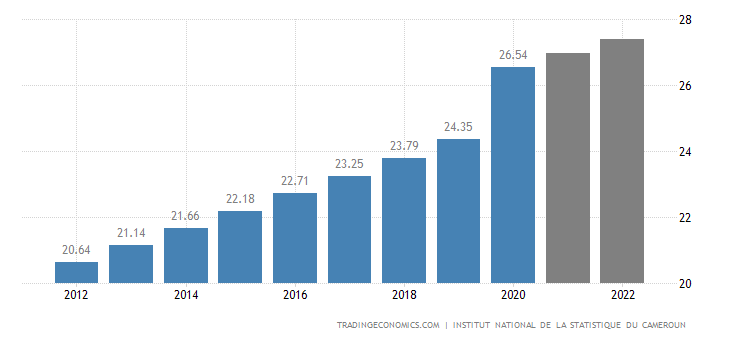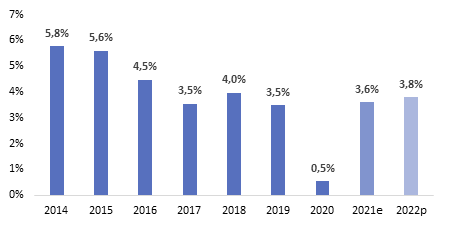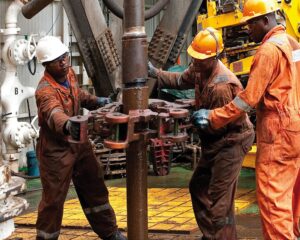CAMEROON – THE AFRICA IN MINIATURE
CAMEROON IN THE HEART OF AFRICA
Referred to as Africa in miniature for its considerable natural resources (climates, land, soils and ecosystems) culture and diversity, Cameroon is located in the heart of the African continent, and covers an area of 475,442 km2, and is located just north of the Equator at the hinge of the West African coastline. Shaped like an irregular triangle, Cameroon extends north-eastward from the Gulf of Guinea to Lake Chad, and borders six coastal and inland countries: Nigeria to the northwest; Chad and the Central African Republic to the north and northeast; and the Congo, Gabon, and Equatorial Guinea to the south.
Opened on 600 km of coast with the Atlantic and sharing to the west along the border with the Federal Republic of Nigeria, a member of the Economic Community of West African States (ECOWAS), Cameroon is part of the Central African Countries and is bounded to the east by 5 (five) countries of this vast economic zone (Chad, Central African Republic, Congo Gabon and Equatorial Guinea). It is, therefore, a privileged strategic crossroads between Central and West Africa.
This exceptional geographical position is reinforced by the cultural proximity to the English-speaking (Nigeria) and French-speaking (Central Africa) communities, which stems from the broad knowledge of English and French, its official languages.
Its membership in the Economic and Monetary Community of Central African States (CEMAC) and the Economic Community of Central African States (ECCAS) and intra-community trade allow Cameroon to benefit from an estimated market of more than 300,000,000 consumers, according to Nigeria, the Democratic Republic of Congo and Sudan.





ECONOMIC RESILIENCE
Cameroon’s market-based, diversified economy features oil and gas, timber, aluminum, agriculture, mining and the service sector. Oil remains Cameroon’s main export commodity, and despite falling global oil prices, still accounts for nearly 40% of exports. Cameroon’s economy suffers from factors that often impact underdeveloped countries, such as stagnant per capital income, a relatively inequitable distribution of income, a top-heavy civil service, endemic corruption, continuing inefficiencies of a large pastoral system in key sectors, and a generally unfavorable climate for business enterprise.
In 2021, GDP growth picked up to 3.5% from 0.5% in 2020, driven by revival of nonoil activity and continued investment. The budget deficit narrowed to 3.1% of GDP in 2021 from 3.3% in the two previous years, stemming from budgetary consolidation measures aimed at reducing expenditure and increasing non-oil budgetary revenue. Of the SDR 264.5 million allocation in August 2021, SDR 61.5 million was used in fiscal year 2021.
Cameroon government aim to become an emerging country by 2035. Since 1990, the government has embarked on various IMF and World Bank programs designed to reform its economy and to stimulate business investment, increase efficiency in agriculture, improve trade, and recapitalize the nation’s banks.
Although the Cameroonian economy is the largest and most diversified in the region – it accounted for 45% of CEMAC GDP in 2021 according to the IMF –, it nevertheless remains dependent on raw products even if the last few years have seen an increase in exports of some processed products (particularly cocoa derivatives). Faced with the numerous crises affecting the region, the Cameroonian economy has nevertheless posted an average annual growth of 4% since the 1980s. It has also withstood the 2014 commodity crisis better than other countries in Central Africa. Growth, which averaged nearly 5% between 2010 and 2014, slowed to 3.5% in 2017 before recovering slightly to 4.0% in 2018. It sagged again in 2019 (3 .5%) due in part to the persistence of security problems in the Far North and the English-speaking West of the country, and the decline in government orders (to be linked to the constraints in terms of public debt).
Govermental reforms
 The Cameroon government has implemented several structural reforms to support its economy and to promote private and foreign investment.
The Cameroon government has implemented several structural reforms to support its economy and to promote private and foreign investment.
- Putting in place a favorable framework and incentive for businesses;
- Developing the human capital through the promotion of training and capacity building;
- Prioritizing investments in infrastructure and production sectors;
- creating and making use of new sources of growth by creating competitiveness poles;
- The ongoing need to accelerate economic growth to improve people’s well-being and meet international commitments.
Cameroon advantages

Cameroon, often considered as Africa in miniature due to its cultural diversity, its landscape, its economy, is considered as the gateway to the sub-region. Cameroon has the following advantages:
- 17 million hectares of exploitable forests, making Cameroon the second largest forest in Africa. In this area, 9.7 million hectares of land is arable and only 19.5% are occupied (approximately 1.9 million hectares);
- A dynamic population estimated at 23.25 million in 2017, 75% of whom are young people under the age of 25;
- Sustained economic growth, with an average annual growth rate of about 4% since 2013;
- Reforms to improve the business climate and promote private investment;
- A diversified economy.
INVESTMENT OPPORTUNITIES AND SECTORS
The desire to improve the attractiveness of the Cameroon destination for investors has led to:
- The creation of entities dedicated to improving the attractiveness of the Destination Cameroon, such as the Investment Promotion Agency, the Competitiveness Regulatory Council, the Cameroon Business Forum, the Business Integration Centers, the Foreign Trade One-Stop Offices, etc.;
- The organization of international meetings such as the International Economic Conference in Yaounde on 17 and 18 May 2016, which enabled the government, local and regional authorities and private businessmen to present their projects to donors;
- The organization of the Cameroon Investment Forum (CIF) by the Investment Promotion Agency, with an investment market;
- Strengthening good governance and transparency in the management of public finances through the creation of supervisory institutions such as the National Anti-Corruption Commission (NACC), the Supreme State Control, the Audit Court, the National Agency for Financial Investigation (ANIF), etc.
- Actions to promote private initiative in Cameroon have multiplied. The potential of Cameroon’s economic market and investment opportunities have been highlighted by the liberalization of certain sectors of activity such as telecommunications, energy, transport and the promotion of priority sectors such as agriculture, livestock and fisheries, social housing, environmental protection, etc. This liberalization has led to the emergence of private operators in sectors such as mobile telephony, ICT, electricity generation, water distribution, distribution of oil and gas products, etc.
This desire to develop a liberal economy has been achieved by:
- The establishment of several decisive institutions such as the Investment Promotion Agency (IPA) established by Decree No. 2005/310 of 1 September 2005, the SME Promotion Agency (APME), the Bank for Small and Medium Enterprises (CB-SME) and the Agency for Standards and Quality (ANOR), among others, provide decisive support for the deployment and performance of local and foreign companies;
- The signing of various legal instruments with specific incentives for investment projects that help achieve the government’s priority objectives. These include the law of 18 April 2013 laying down incentives for private investment in the Republic of Cameroon and its various executive orders, including the order of 3 July 2014 on the composition of the application file to benefit from the benefits provided by the law of 18. April 2013;
- The promotion of programmes to strengthen entrepreneurship in general, especially among young people, such as the Youth Entrepreneurship Promotion Programme, launched by the Cameroon SME Promotion Agency (APME) in partnership with the United Nations Conference on Trade and Development (UNCTAD).
- All these assets among others make Cameroon the leading country of the Economic and Monetary Community of Central Africa (CEMAC), the engine of integration in Central Africa and a “good risk” for foreign investors.
